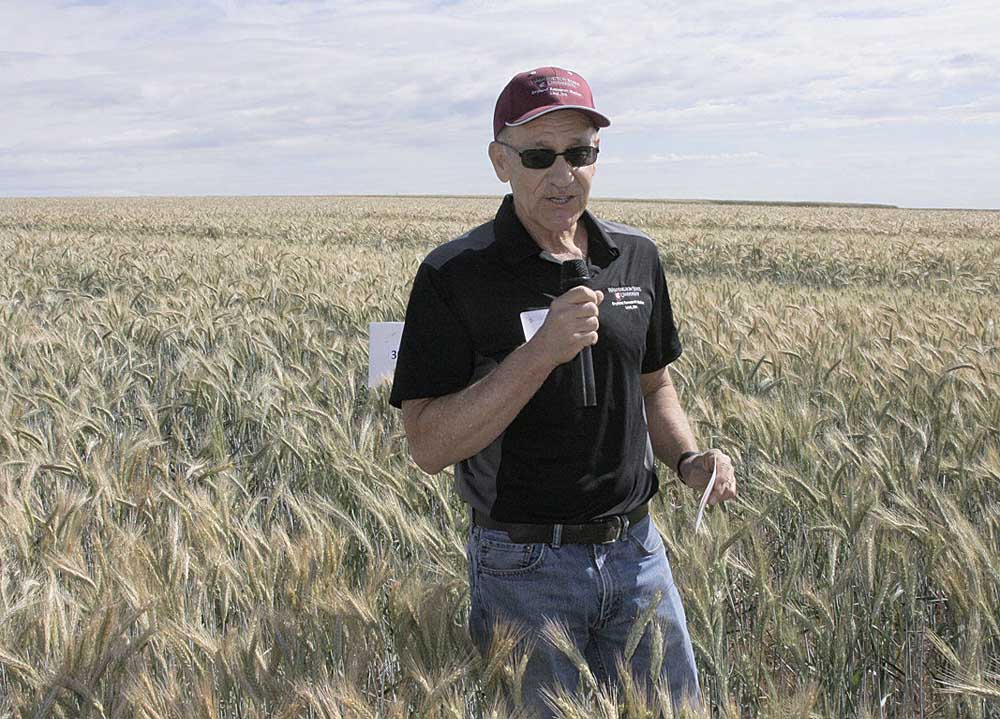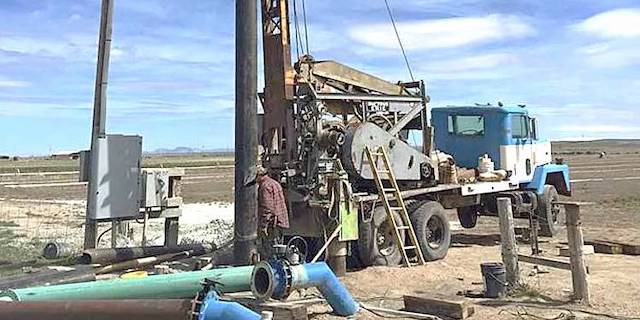Online Auction – Corbett Estate Auction
Corbett Estate Auction Date(s) 4/14/2025 - 4/30/2025 Bidding Opens April 14th at 5pm (pst) Bidding Starts to Close April 30th at 5pm (pst) OFFSITE AUCTION - All items located in […]
Published 12:43 pm Friday, July 3, 2020

Washington State University’s dryland research station in Lind received more than three times the average amount of rain in May, prompting a researcher there to predict higher yields for the region’s wheat crop this year.
With 2.53 inches of rain, May was the third-wettest ever recorded at the station, director Bill Schillinger said. The 100-year average for precipitation at the station in May is 0.80 inches.
“Rain in the month of May and the first two weeks of June (are) the most important for any time period for grain yield potential of both winter wheat and spring wheat,” Schillinger told the Capital Press. “We know this for certain. So, farmers really caught a break this year. It was looking bleak up through April because of drought.”
Schillinger expects wheat yields to be “substantially” above average, with some fields doing “exceptionally well.”
“May was sort of our salvation,” he said. “Cool temps, region-wide rain. … We lucked out.”
In the last 100 years, the station has averaged 9.63 inches a year, Schillinger said. Precipitation is what falls as snow and rain, he said.
This crop year, through June 26, the station had 10.40 inches.
According to station records, the wettest year on record was 1948, with 22.71 inches of precipitation.
Corbett Estate Auction Date(s) 4/14/2025 - 4/30/2025 Bidding Opens April 14th at 5pm (pst) Bidding Starts to Close April 30th at 5pm (pst) OFFSITE AUCTION - All items located in […]
APRIL AUCTION SCHEDULE Tuesday, April 22nd Open Consignment Feeder Sale All cattle welcome Monday, April 28th Sheep & Goat Auction Tuesday, April 29th Livestock Auction All cattle welcome LEBANON AUCTION […]
MERIDIAN EQUIPMENT MAY BIMONTHLY Public ONLINE Auction Meridian Equipment Auction CO. Bellingham WA, Auction Bidding Opens: April 26, 2025 Auction Bidding Ends: May 10 & 11, 2025 www.Meridianeq.com www.Meridianeq.Hibid.com 360-398-2141 […]
THIS WILL BE AN ONLINE AUCTION Go to bakerauction.com for more information. Auction Soft Closes: Monday, April 28th 2025 @ 12:00pm MT Location: 15450 Haines Cemetery Ln. Haines, OR 97833 […]
Online Auction Demas Family Retirement Auction Winnemucca, Nevada Bidding Now Open - No Buyer's Premium Starts Closing: Tuesday, April 29th @2PM (MT) Full line of Hay Equipment, Stackers, Tractors, Balers, […]
April 30th, 2025 Online Auction Only. Dairy, Farm, and Heavy Equipment, Transportation, Tool & More. Bidding Ends April 30th, 2025 at 10AM, MST Magic Valley Auction 1218 E. Iona […]
Wednesday, April 30, 2025 11:00 PST - Golconda, Nevada Live & Online Bidding Tractors - JD Telehandler - Loaders - Backhoe - Dozers - Hay Equipment - Trucks - Miscellaneous […]
TIMED ONLINE ONLY - View Catalog Complete lineup of well-maintained late model tractors, trucks, potato equipment & more. Location: 3656 N 5000 E, Sugar City, ID 83448 Equipment Preview available […]
Booker's Annual Spring May Eltopia Auction May 1-2, 2025 Day 1 - May 1, 2025 Start Time: 4/25/2025 12:00 AM End Time: 5/1/2025 10:00 AM Day 2 - […]
THIS WILL BE AN ONLINE AUCTION Go to bakerauction.com for more information. Auction Soft Closes: Friday, May 2nd 2025 @ 12:00pm MDT Ford 545C 2WD diesel Loader tractor (LOW HRS), […]
Yoder Antique Farm Collection Auction Live In Person Auction Saturday May 3rd, 2025 @ 9:00 am. Doors Open at 8 am 9313 S Schnieder Rd Molalla, Oregon 97038 Preview Friday […]
MAY ONLINE EQUIPMENT CONSIGNMENT AUCTION ONLINE BIDDING WILL BE WED MAY 7TH TO WED MAY 14TH DELIVERY SCHEDULE: EQUIPMENT ONLY DELIVERY WILL BE ON […]
Public Online Auction Marks Design & Metalworks Fabrication Shop & Rolling Stock Start Date: 10AM | Wednesday - May 7 End Date: 10AM | Wednesday - May 14 Preview: 8AM […]
BID ONLINE NOW Spring Big Boy Toys Auction Ends Thurs. May 8th, 6PM MDT Featuring Everything A Big Boy Could Want!!! Classic Cars & Luxury Vehicles, RV's, Heavy Equipment, Motorsports, […]
Magic Valley Auction Online Summer Auction Dairy, Farm, Excavation & Heavy Equipment, Transportation, Tools & More! Bidding Opens May 14 Bidding Ends June 11th, 10AM MST https://www.mvaidaho.com 208-536-5000 5651 US […]
Estate of Mike Brock Online Only Auction Now Open For Bidding Location: 1828 Amelia St. & 301 E. Aeronca Walla Walla, WA. 99362 Preview: May 9th, 10:00am-4:00pm PDT Begins Closing: […]
SunRain Potato Varieties Auction & Spring Farm & Construction Online Auction ONLINE ONLY AUCTION Bidding Starts April 29th Bids Close May 13th Multiple Locations - Please See Individual Lots For […]
ONLINE ONLY 800+ LOTS EXPECTED OF CONSTRUCTION & AGRICULTURAL EQUIPMENT, VEHICLES, TRAILERS, ATV'S, CAMPERS, EXCAVATORS, SKID STEERS, LAWN MOWERS, SKID STEER ATTACHMENTS & MORE! Bidding Ends: Wednesday, May 14th @ […]
Booker's Annual Spring Offsite Farm Auction 2025 Ends May 14, 2025 Booker Auction Company www.BookerAuction.com | 509.297.9292
Virtual Online Only Friday, May 16th • 9AM PDT Open House: Thursday, May 15th / 12:00pm - 3:00pm 18050 Rd 5 SW Quincy, WA (4) Freeman 370 Engine Balers Freeman […]
5th Annual Western Oregon Ram Sale Join us online Saturday May 17th Start Time: 5/10/2025 6:00:00 PM End Time: 5/17/2025 6:00:00 PM 40+ yearling rams available Handpicked for highest quality 100% Willamette […]
Bernards Farm Liquidation Auction Live Public Auction-2 Auctioneers-2 Rings Saturday May 17, 2025 @ 9:00 am 18755 OR-18 McMinnville, Oregon 97128 Previews Thursday and Friday May 15th and 16th, 2025, […]
Late Spring Farm & Heavy Equipment Auction Begins to close @3pm MST | March 19, 2025 Early Listings: *2008 John Deere 5525 Tractor, *Case CX50B Excavator, *CAT 308E2 CR Excavator, […]
SPRING CONSIGNMENT AUCTION Saturday, May 24th, 2025 • 9 a.m. 56946 Hwy 140 E. Bly, OR Preview Friday 8 a.m. - 5 p.m. Consignments coming in daily! Tractors • Trucks […]
Live Streaming Auction - May 28, 2025 Timed Auction (Online Only!) - May 29, 2025 View Catalogs: Day 1 | Day 2
Cut Above Enterprises, Inc. Booker Auction is privileged to partner with Cut Above Enterprises, Inc, a valuable resource in grain handling and storage fabrication in the PNW. This auction features […]
CHEYENNE DAIRIES, NM Complete Heifer Dispersal Saturday, May 31, 2025 - 11:00 AM MST Selling: 10,000 Holstein Heifers Weaned Calves to Springers TB Tested Prior to Sale, Ready to Ship […]
Sullivan Living Estate Auction Live Public Auction Saturday May 31st, 2025, at 9:00 am. Doors Open at 8 am Preview Friday May 30th 9-3pm 25382 Rice Rd Sweet Home, Oregon […]
Rowland Auction Service Annual Consignment Auction Farm & Livestock Equipment Saturday, May 31, 2025 COTTONWOOD, IDAHO • Located at Cottonwood Livestock Auction 2151 Hwy 95 N – ½ mile south […]
Multi Estate Auction Sunday, June 1st For Photos and Online Bidding, Go To fordsauction.com Location: 2220 SE Kelli Blvd Hermiston, OR 97838 Highlights Include: A large collection of saddles, horse […]



